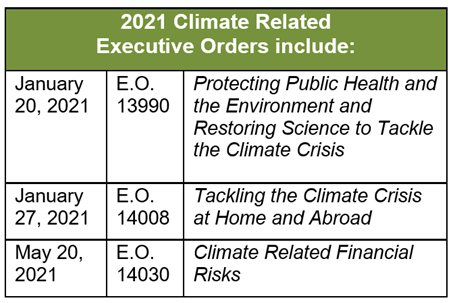
Manage Your GHG Emissions to Stay Competitive in the Federal Marketplace
Post filed in: Acquisition
In our last blog on sustainability, I offered an overview of how GSA’s Federal Acquisition Service (FAS) supports sustainable acquisition and supply chain climate risk management throughout the acquisition life cycle. Now let’s look at new federal policies that incentivize federal contractors to manage their greenhouse gas (GHG) emissions.
According to NASA’s Global Climate Change website, the planet’s average surface temperature has risen about 2.12 degrees Fahrenheit since the late 19th century, a change driven largely by increased carbon dioxide and other GHG emissions into the atmosphere and other human activities, such as water consumption. In fact, most of the warming occurred in the past forty (40) years, with the seven (7) most recent years being the warmest. The years 2016 and 2020 are tied for the warmest year on record.
Recent Executive Orders (E.O) seek to leverage the purchasing power of the federal government to track and incentivize the reduction of climate change impacts. Notably, Executive Order 14030 directs the Federal Acquisition Regulatory (FAR) Council, in consultation with the Chair of the Council on Environmental Quality and the heads of other agencies as appropriate, to consider amending the FAR to:

- Require major Federal suppliers to publicly disclose GHG emissions and climate-related financial risk and to set science-based reduction targets;
- Ensure that major Federal agency procurements minimize the risk of climate change, including requiring the social cost of GHG emissions be considered in procurement decisions; and
- Where appropriate and feasible, give preference to bids and proposals from suppliers with a lower social cost of GHG emissions.
GSA is tracking our suppliers’ progress using FAR provision 52.223-22 Public Disclosure of Greenhouse Gas Emissions and Reduction Goals - Representation (DEC 2016). Since 2016, offerors that have received $7.5 million or more in federal contracts in the prior federal fiscal year are required to indicate if they publicly disclose or set targets to reduce emissions.
You may be asking: “How do I track and reduce my GHG emissions?” I’m glad you asked! (You may also be asking: “What do you do with the information, or why do you collect it?” — that’s a subject for another blog … stay tuned!).
The Environmental Protection Agency Center for Corporate Climate Leadership serves as a resource center for all organizations to track and reduce their climate impacts. The EPA provides a four-step GHG Inventory Development process:
- Get Started: Scope and Plan Inventory. This presentation on EPA’s GHG Management Tools and Resources [PDF] is an excellent resource to check out if you’re getting started! If you’re a small business, the EPA has developed guidance specifically for you. Check out EPA’s Guide to Greenhouse Gas Management for Small Business and Low Emitters [PDF].
- Collect Data and Quantify GHG Emissions. For this step, you need to figure out what data you need, how to collect it, select your emission factors, and calculate emissions. This can be challenging; however, EPA’s Center for Corporate Climate Leadership has several GHG Management Resources to assist you. The Simplified GHG Emissions Calculator is a particularly helpful resource for small and medium-size businesses.
- Develop a GHG Inventory Management Plan. An Inventory Management Plan (IMP) describes an organization’s process for completing a high-quality, corporate-wide GHG inventory. Organizations use an IMP to institutionalize a process for collecting, calculating, and maintaining GHG data. EPA’s Inventory Management Plan guidance is available here.
- Set a GHG Emission Reduction Target and Report Progress. Now that your IMP is in place, report your data, set a GHG target, and begin reducing your emissions. Public disclosures are usually made on company websites or through third-party environmental disclosure systems (e.g., the Carbon Disclosure Project (CDP)). Guidance on GHG target setting is available on EPA’s Target Setting page and additional guidance for setting a “science-based” target is available from the Science Based Targets Initiative linked on EPA’s site. [Please note, the Carbon Disclosure Project is non-governmental. It is provided for informational purposes only, and is neither affiliated with, nor endorsed by, GSA.]
GHG Management is no simple task. The good news is you don’t have to wait to begin reducing your GHG emissions! Here are some ways to start reducing your footprint:
- If you own your commercial facility, buy renewable energy (see EPA’s Green Power Partnership) and/or make your facility more energy-efficient.
- Shift your owned or leased fleets, or any domestic delivery services, to electric vehicles.
- Purchase and use sustainable products. We can help with information on that — the GSA Green Procurement Compilation provides a list of sustainable products federal agencies are required to purchase.
- Make or sell green products that conform to Standards and Ecolabels Recommended by EPA. Manufacturers: Certify your products! Resellers or distributors: Identify green products on Federal market platforms (e.g., GSA Advantage).
- Work with EPA Smartway to reduce GHG from goods your company ships or receives.
In the first quarter of FY22, GSA and EPA will offer a recorded presentation specifically for federal contractors interested in learning more about GHG management. Please be on the lookout on Interact for more information.
Climate change is an immense challenge that will require action across society — including federal procurement. Managing GHG emissions can be challenging but resources are available to assist industry partners willing to rise to the occasion. Successful contractors will be well positioned to succeed in the federal marketplace over the next several years. I would encourage all of our industry partners to begin taking action now!

 U.S. General Services Administration
U.S. General Services Administration
